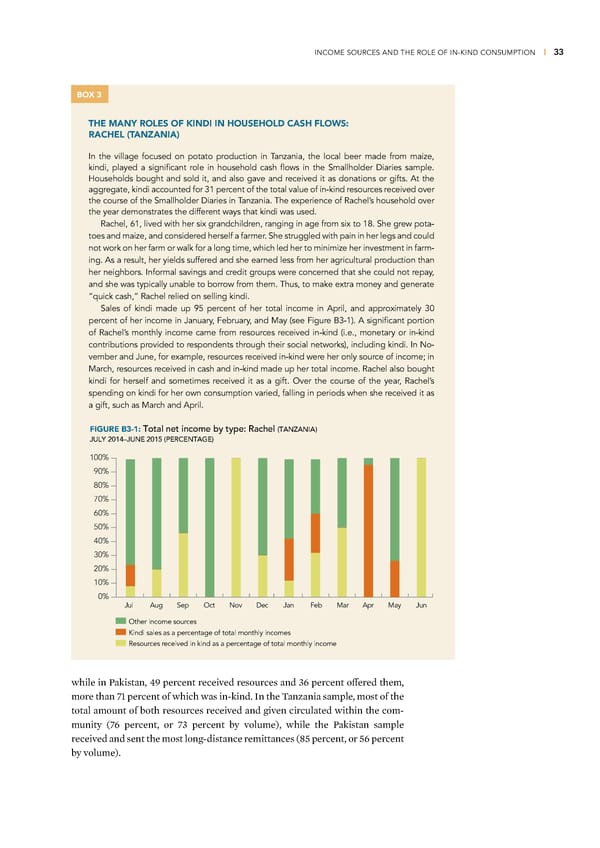INCOME SOURCES AND THE ROLE OF IN-KIND CONSUMPTION | 33 BOX 3 THE MANY ROLES OF KINDI IN HOUSEHOLD CASH FLOWS: RACHEL (TANZANIA) In the village focused on potato production in Tanzania, the local beer made from maize, kindi, played a significant role in household cash flows in the Smallholder Diaries sample. Households bought and sold it, and also gave and received it as donations or gifts. At the aggregate, kindi accounted for 31 percent of the total value of in-kind resources received over the course of the Smallholder Diaries in Tanzania. The experience of Rachel’s household over the year demonstrates the different ways that kindi was used. Rachel, 61, lived with her six grandchildren, ranging in age from six to 18. She grew pota- toes and maize, and considered herself a farmer. She struggled with pain in her legs and could not work on her farm or walk for a long time, which led her to minimize her investment in farm- ing. As a result, her yields suffered and she earned less from her agricultural production than her neighbors. Informal savings and credit groups were concerned that she could not repay, and she was typically unable to borrow from them. Thus, to make extra money and generate “quick cash,” Rachel relied on selling kindi. Sales of kindi made up 95 percent of her total income in April, and approximately 30 percent of her income in January, February, and May (see Figure B3-1). A significant portion of Rachel’s monthly income came from resources received in-kind (i.e., monetary or in-kind contributions provided to respondents through their social networks), including kindi. In No- vember and June, for example, resources received in-kind were her only source of income; in March, resources received in cash and in-kind made up her total income. Rachel also bought kindi for herself and sometimes received it as a gift. Over the course of the year, Rachel’s spending on kindi for her own consumption varied, falling in periods when she received it as a gift, such as March and April. FIGURE B3-1: Total net income by type: Rachel (TANZANIA) JULY 2014–JUNE 2015 (PERCENTAGE) 100% 90% 80% 70% 60% 50% 40% 30% 20% 10% 0% JulAug Sep Oct Nov Dec Jan Feb Mar Apr May Jun Other income sources Kindi sales as a percentage of total monthly incomes Resources received in kind as a percentage of total monthly income while in aistan, “ž percent received resources and Ÿ¢ percent offered them, more than •… percent of which was in-ind €n the Œan—ania sample, most of the total amount of both resources received and given circulated within the com- munity (•¢ percent, or •Ÿ percent by volume), while the aistan sample received and sent the most long-distance remittances (¡” percent, or ”¢ percent by volume)
 Financial Diaries with Smallholder Families Page 45 Page 47
Financial Diaries with Smallholder Families Page 45 Page 47